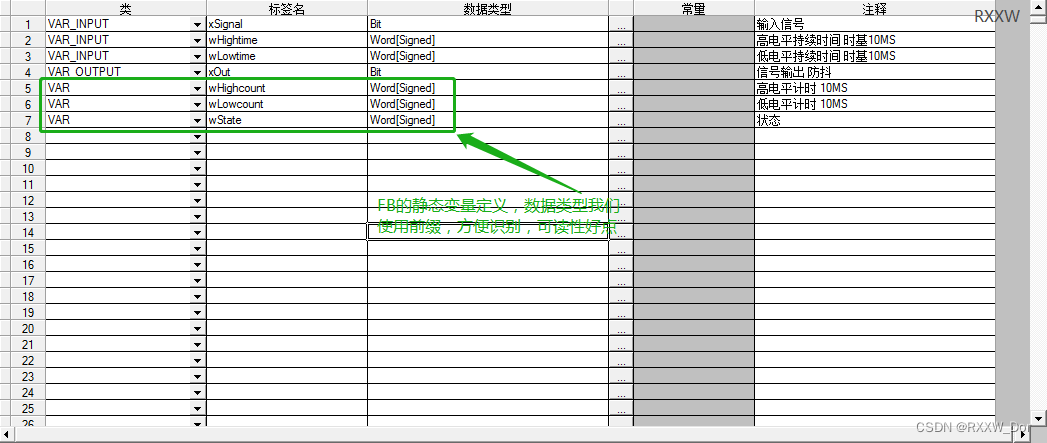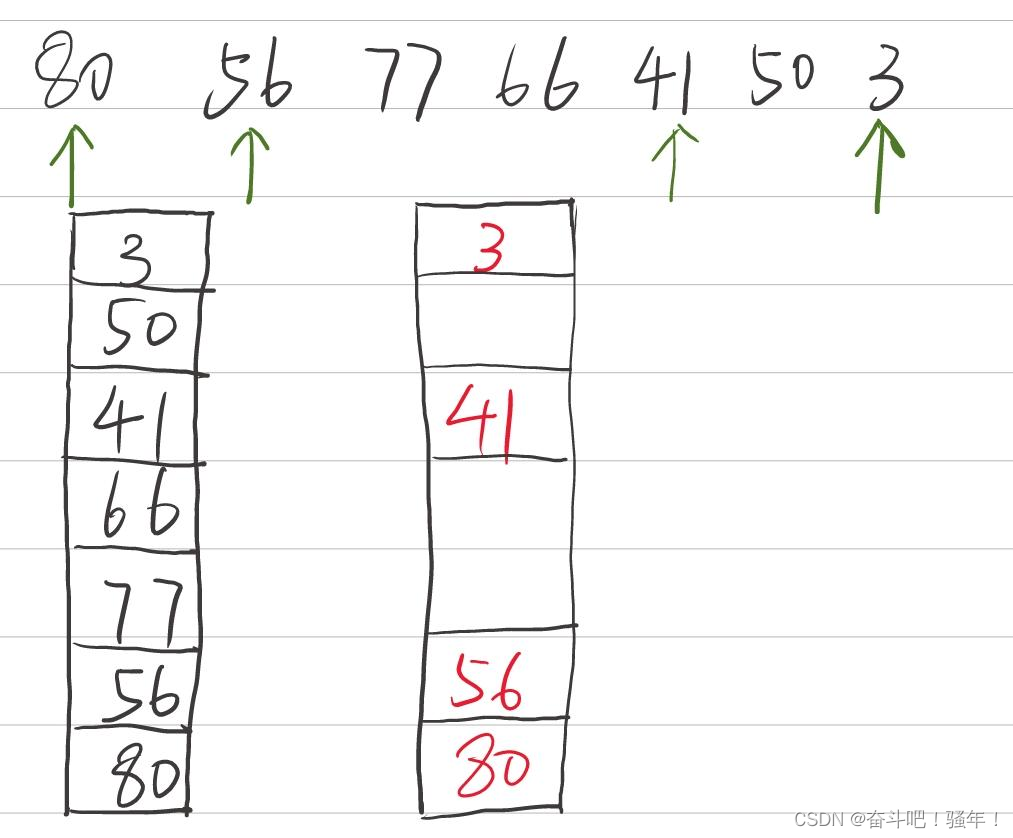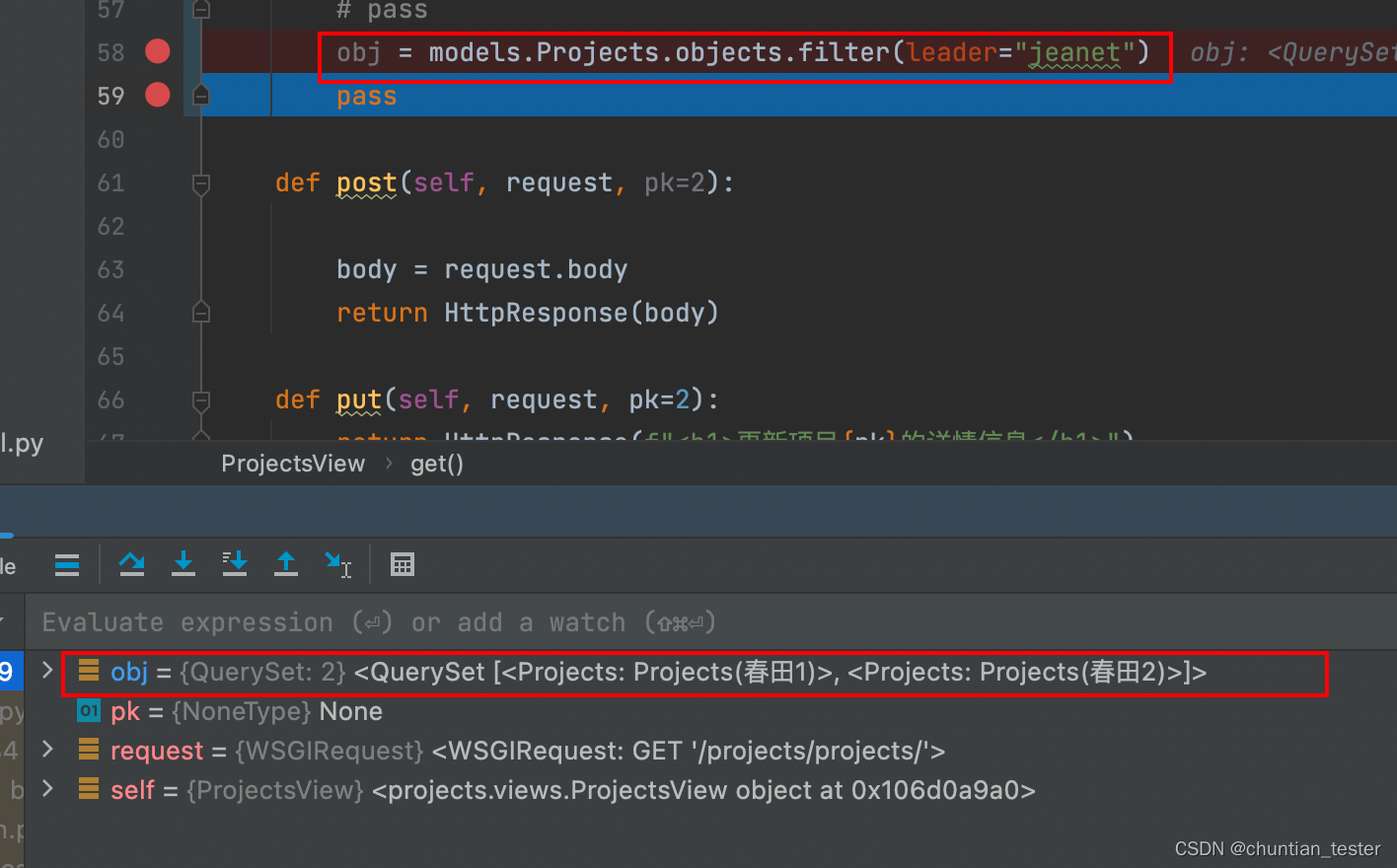当前位置:网站首页>ES类和对象、原型
ES类和对象、原型
2022-07-07 07:20:00 【小白啥时候能进阶成功】
一、“前端开发”名称的由来
Web1.0时代的网页制作:网页主要是静态页面,无法和服务器进行交互。网站开发工具(网页三剑客):DreamWeaver、FireWorks、Flash。
- Web2.0时代的前端开发:现在的页面开发,无法从开发维度还是开发方式上,更接近传统的网站后台开发,因此不再叫做“页面制作”,而是“前端开发”。新三剑客:HTML、CSS和JavaScript。
- HTML:超文本标记语言,是一门描述性语言。
- CSS:层叠样式表,是用来控制网页外观的一种技术。
- JavaScript:即JS,是一种嵌入到 HTML页面中的脚本语言,由浏览器一边解释一边执行。
HTML用于控制网页的结构,CSS用于控制网页的外观,而JavaScript控制着网页的行为。
二、ES的类和对象
1、Class关键字;
2、constructor构造函数;
3、方法前不需要function关键字;
4、方法之间不需要逗号
5、extends继承和super()关键字:extends表示继承(C中的public)
<script type="text/javascript">
class Father{
constructor(x,y)
{
this.x = x;
this.y =y;
}
sum()
{
console.log("father's sum:"+(this.x+this.y));
}
song()
{
console.log("father is sing qinghuaci");
}
}
class Son extends Father{
constructor(x,y)
{
super(x,y); //调用了父类中的构造函数
}
}
var son1 = new Son(3,4);
son1.sum();
son1.song();
</script>6、super关键字: 在子类的构造器中,通过调用super(),则向父类的构造函数中传递参数。
class Son extends Father{
constructor(x,y)
{
super(x,y); //1、调用了父类中的构造函数,赋值给父类的this对象
}
}7、super关键字:通过使用“super.属性”或“super.方法”的方式,显示调用父类中声明的属性和方法。
class Son extends Father{
song()
{
console.log("son is sing qinghuaci");//2、子类的song方法
super.song();//3、调用父类的song方法
}
}子类调用方法时,先遍历子类是否有该函数,如果有,则执行子类的函数。如果没有,则遍历父类,执行父类的函数。
8、super必须放在子类的this前面
class Son extends Father{
constructor(x,y)
{
super(x,y); //1、调用了父类中的构造函数,赋值给父类的this对象
this.x = x; //2、将x,y传递给自己的this对象
this.y = y;
}
}9、this的指向问题
(1)constructor里面的this指向的是创建的实例对象;
(2)方法中的this指向的是调用者;例如:下面的例子中,sum方法中的this指向的是这个按钮,因为按钮调用了这个方法。
<!DOCTYPE html>
<html>
<head>
<title>CanvasTest</title>
<meta charset="UTF-8">
<div class="items">
<button>Play</button>
</div>
</head>
<body>
<script type="text/javascript">
class Father{
constructor(x,y)
{
this.x = x;
this.y =y;
this.btn = document.querySelector("button");
this.btn.onclick = this.sum;
}
sum()
{
//这个sum方法中的this指向的是这个按钮,因为这个按钮调用了sum函数
console.log(this);
console.log("father's sum:"+(this.x+this.y));
}
}
var f = new Father(2,5);
</script>
</body>
</html>三、构造函数和原型
1、不同对象的方法会重复申请内存进行创建
function Star(){
this.name = uname;
this.age = age;
this.sing=function()
{
console.log("sing song");
}
}
var ldh = new Star("刘德华");
var zxy = new Star("张学友");
ldh.sing();
zxy.sing();
console.log(ldh.sing() ==== zxy.sing());//false,是两个函数ldh和zxy的song方法分别在两个地址。
2、构造函数原型
每一个构造函数都有一个prototype属性,这个prototype就是一个对象,这个对象的所有属性和方法,都会被构造函数所拥有。
构造函数通过原型分配的函数是所有对象所共享的。可以把那些不变的方法,直接定义在prototype对象上,这样所有对象的实例就可以共享这些方法。
function Star(uname,age){
this.name = uname;
this.age = age;
}
//song放到了构造函数的原型对象里面了。
Star.prototype.sing = function()
{
console.log("sing song");
}
var ldh = new Star("liudehua");
var zxy = new Star("张学友");
ldh.sing();//在构造函数的原型对象上找到song方法
zxy.sing();一般情况下,我们的公共属性定义到构造函数里面,公共方法我们放到原型对象身上。
3、对象原型 __proto__
实例化后的对象系统自动添加一个属性:__proto__,他指向构造函数的原型对象prototype。
对象的属性__proto__和构造函数的原型对象prototype等价。
function Star(uname,age){
this.name = uname;
this.age = age;
}
Star.prototype.song = function()
{
console.log("sing song");
}
var ldh = new Star("liudehua");
var zxy = new Star("张学友");
console.log(ldh.__proto__ === Star.prototype);//true;
ldh.sing();查找规则:首先看ldh对象身上是否有sing方法,如果有,执行对象的sing方法。如果没有,去构造函数原型对象身上查找。
4、constructor函数
对象原型(__proto__)和构造函数原型对象(prototype)里面都有一个constructor属性;constructor我们称为构造函数,因为它指回构造函数本身。
作用一:constructor主要用于记录该对象引用于哪个构造函数,它可以让原型对象重新指向原来的构造函数。
function Star(uname,age){
this.name = uname;
this.age = age;
}
// 把原型对象赋值成一个新的对象
Star.prototype.sing(){
console.log("sing song");
}
var ldh = new Star("liudehua");
var zxy = new Star("张学友");
console.log(ldh.__proto__.constructor);
console.log(Star.prototype.constructor);运行结果:
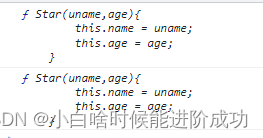
作用二:很多情况下,我们需要手动地利用constructor这个属性指回原来的构造函数。
function Star(uname,age){
this.name = uname;
this.age = age;
}
// 把原型对象赋值成一个新的对象
Star.prototype = {
sing:function(){
console.log("sing song");
},
movie:function(){
}
}
var ldh = new Star("liudehua");
var zxy = new Star("张学友");
console.log(ldh.__proto__.constructor);
console.log(Star.prototype.constructor);结果:

原型对象的constructor指向的不是Star,是因为Star的原型对象被覆盖了,因此原型对象中的constructor不再指向Star.
解决方法:
function Star(uname,age){
this.name = uname;
this.age = age;
}
// 把原型对象赋值成一个新的对象
Star.prototype = {
constructor:Star,//指回原先的构造函数
sing:function(){
console.log("sing song");
},
movie:function(){
}
}
var ldh = new Star("liudehua");
var zxy = new Star("张学友");
console.log(ldh.__proto__.constructor);
console.log(Star.prototype.constructor);结果:
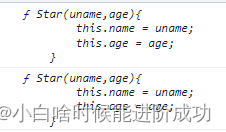
总结:如果修改了原来的原型对象,给原型对象赋值的是一个对象,则必须手动地利用constructor指回原来的构造。
5、构造函数、实例、原型对象三者之间的关系
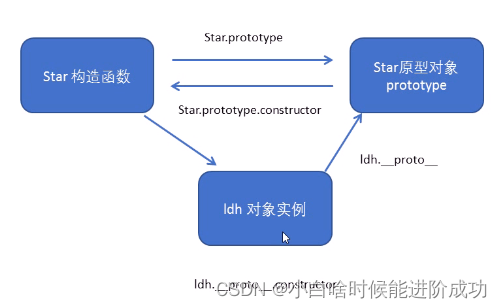
边栏推荐
- Thinkphp3.2 information disclosure
- Can't connect to MySQL server on '(10060) solution summary
- CDZSC_ 2022 winter vacation personal training match level 21 (2)
- Sqlplus garbled code problem, find the solution
- Analyze Android event distribution mechanism according to popular interview questions (II) -- event conflict analysis and handling
- Strategic cooperation subquery becomes the secret weapon of Octopus web browser
- Introduction to automated testing framework
- 基础篇:带你从头到尾玩转注解
- The Himalaya web version will pop up after each pause. It is recommended to download the client solution
- ViewPager2和VIewPager的区别以及ViewPager2实现轮播图
猜你喜欢
随机推荐
ORM--数据库增删改查操作逻辑
Guys, how can mysql-cdc convert the upsert message to append only
大佬们,有没有遇到过flink cdc读MySQLbinlog丢数据的情况,每次任务重启就有概率丢数
CDZSC_2022寒假个人训练赛21级(2)
request对象对请求体,请求头参数的解析
Impression notes finally support the default markdown preview mode
flink. CDC sqlserver. You can write the DEM without connector in sqlserver again
**Grafana installation**
Write it into the SR table in the way of flinksql. It is found that the data to be deleted has not been deleted. Refer to the document https://do
Future development blueprint of agriculture and animal husbandry -- vertical agriculture + artificial meat
Horizontal split of database
Web3.0 series distributed storage IPFs
Performance optimization record of the company's product "yunzhujia"
phpcms实现PC网站接入微信Native支付
Pit using BigDecimal
小程序弹出半角遮罩层
Sqlplus garbled code problem, find the solution
Pytest learning - dayone
ORM模型--数据记录的创建操作,查询操作
Scratch crawler mysql, Django, etc
